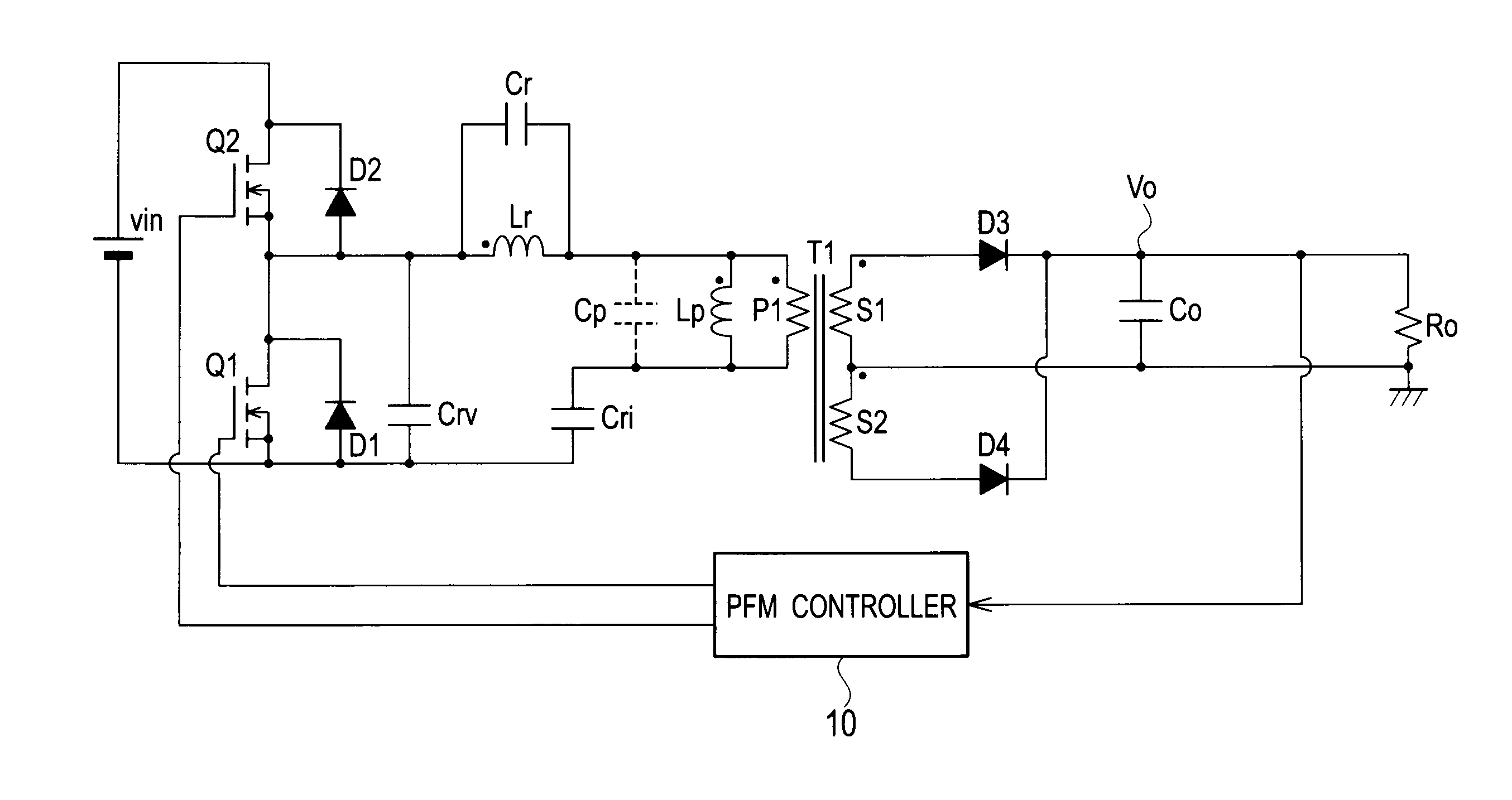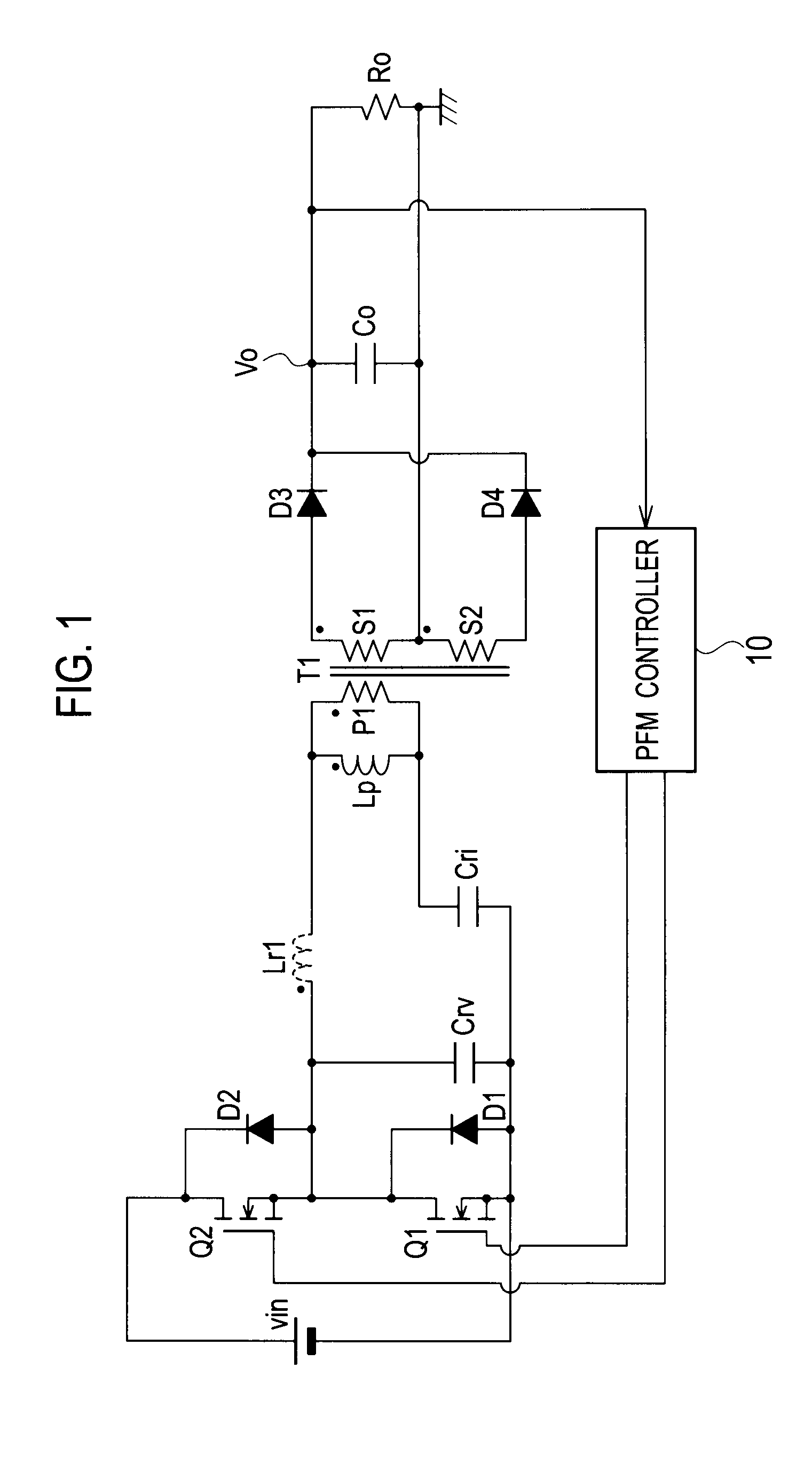DC converter
a converter and dc technology, applied in the direction of dc-dc conversion, power conversion systems, climate sustainability, etc., can solve the problems of inability to set such a high level of frequency at rated load, cross regulation becomes worse, etc., to prevent the increase of frequency at no load, small, inexpensive, and high-efficiency dc
- Summary
- Abstract
- Description
- Claims
- Application Information
AI Technical Summary
Benefits of technology
Problems solved by technology
Method used
Image
Examples
example 1
[0061]In Example 1 illustrated in FIG. 8, in order to bypass a charge amount corresponding to charge and discharge of the floating capacitance Cp equivalently present between the primary winding P1 of the transformer T1, a capacitor Cr (capacitive element) connected to a current resonant reactor Lr in parallel is provided. Thus, charge and discharge energy of the parasitic capacitances of the diodes D3 and D4 has been configured not to be stored in the current resonant reactor Lr. That means the capacitor Cr is connected to the current resonant reactor Lr in parallel, whereby a current due to charge and discharge of the floating capacitance Cp between the primary winding P1 of the transformer T1 has been configured not to pass through the current resonant reactor Lr.
[0062]In Example 1 illustrated in FIG. 8, a series resonant circuit composed of the current resonant reactor Lr, the primary winding P1 of the transformer T1, and the current resonant capacitor Cri is connected to the sw...
example 2
[0070]FIG. 11 is a circuit configuration diagram of a DC converter in Example 2 of the present invention. The floating capacitance Cp between the primary winding P1 of the transformer T1 includes a resistance component in series. Therefore, Example 2 can be represented by an equivalent circuit, which is composed of a series circuit of the floating capacitance Cp and a resistance Rp as illustrated in FIG. 11.
[0071]Thus, as illustrated in FIG. 11, the circuit configuration, in which a series circuit of the capacitor Cr and a resistor Rr is connected to the current resonant reactor Lr in parallel while corresponding to the series circuit of the floating capacitance Cp and the resistance Rp, is appropriate as the actual circuit configuration.
[0072]In Example 2 illustrated in FIG. 11, similar to Example 1, an influence of the reactor Lp can be cancelled by setting the capacitor Cr and the resistor Rr to meet the following formulae,
Cr=LpLr·Cp,Rr=LrLp·Rp.[Math3]
[0073]That means the value o...
example 3
[0075]FIG. 12 is a circuit configuration diagram of a DC converter in Example 3 of the present invention. In Example 3 illustrated in FIG. 12, compared to Example 2 illustrated in FIG. 11, a transformer T2 including the primary winding P1 and the secondary winding S1 is provided while removing the secondary winding S2 and the diode D4, and a PRC controller 11 is employed.
[0076]The PRC controller 11 fixes an on-time of one switching element Q1 (or Q2), and varies an ontime of the other switching element Q2 (or Q1). Thus, a DC output voltage Vo is controlled. Note that, both of the switching elements Q1 and Q2 have a dead time that is in an off state of both of the switching elements Q1 and Q2 simultaneously.
[0077]According to such a configuration, when the switching element Q2 is an on state, a current passes through the capacitor Co via the diode D3 from the secondary winding S1 of the transformer T2. Accordingly, power is applied to a load Ro. While, when the switching element Q1 i...
PUM
 Login to View More
Login to View More Abstract
Description
Claims
Application Information
 Login to View More
Login to View More - R&D
- Intellectual Property
- Life Sciences
- Materials
- Tech Scout
- Unparalleled Data Quality
- Higher Quality Content
- 60% Fewer Hallucinations
Browse by: Latest US Patents, China's latest patents, Technical Efficacy Thesaurus, Application Domain, Technology Topic, Popular Technical Reports.
© 2025 PatSnap. All rights reserved.Legal|Privacy policy|Modern Slavery Act Transparency Statement|Sitemap|About US| Contact US: help@patsnap.com



